Today we will do a virtual tour of the Punakha Dzong. Although there are many dzongs in Bhutan. But the Punakha dzong is the second largest of all. Also, it is located at the best possible location that one can think of for a strategic fortress. (The word “dzong” literally means “fortress-monastery”). And there are many dzongs that we visited while on our trip to Bhutan. But I liked the Punakha Dzong the best. It is located at the confluence of two rivers. And is accessible only via a wooden bridge across the river.
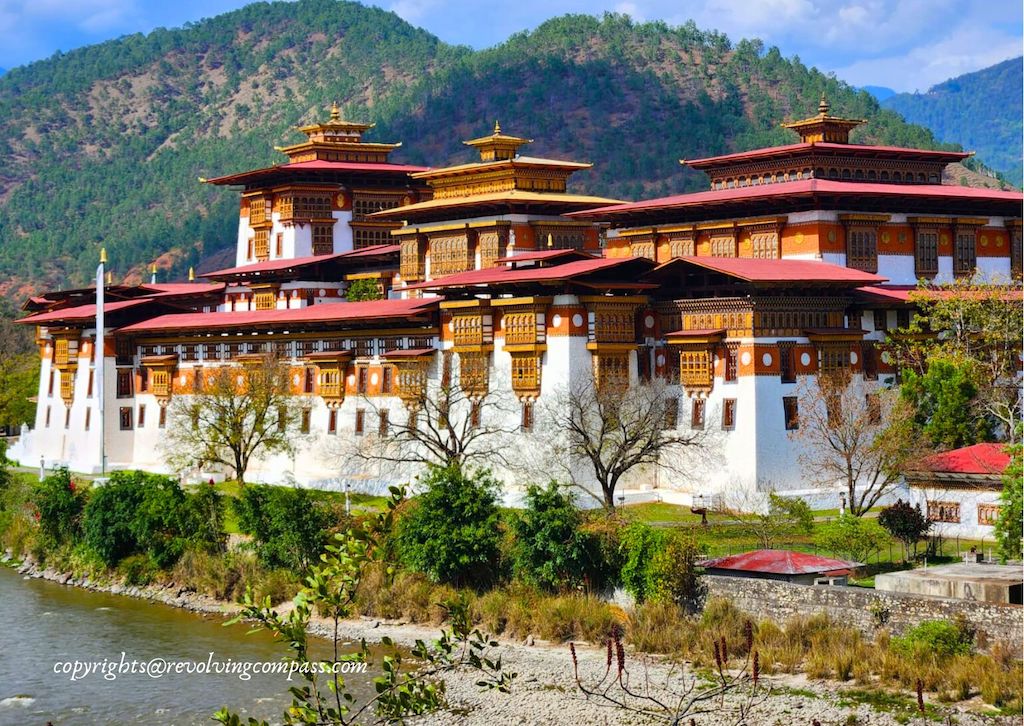
During our 7 days Bhutan trip, on the day of our trip from Thimphu to Punakha, we visited the Punakha Dzong after reaching the town. Although I have visited many forts, mostly in India. Which are much more majestic, vast and robust. Like the Chittorgarh Fort, the Kumbhalgarh fort, the Amer Fort, Jaisalmer Fort, Nahargarh Fort and the majestic Mehrangarh Fort in Rajasthan. The Chitradurga Fort in south India. And most recently on our 7 days Kerala road trip, the Padmnabhapuram Palace in Kanyakumari. But, I had never seen an architecture like the one at Punakha Dzong. It is so different and so unique. As I take you on a virtual tour of the Punakha dzong with me in this writeup, you will realise what I am talking about.
Table of Contents
First glimpses of the Punakha Dzong from across the viewpoint on highway
As we entered Punakha, we gasped at the beauty of the valley, the river flowing through it and the mountains guarding it like soldiers. With every turn of our vehicle, we were going “click – click” on our camera. Yet I felt miserable at being able to capture the true beauty of this Himalayan valley in the camera. Thats when our guide, Dorgie said – wait , there is a viewpoint ahead. You will get really good shots from there. I thought it was going to be another spot to get a really good angle of the mountains and the valleys in front of us. Until, we actually reached the spot and stopped there.
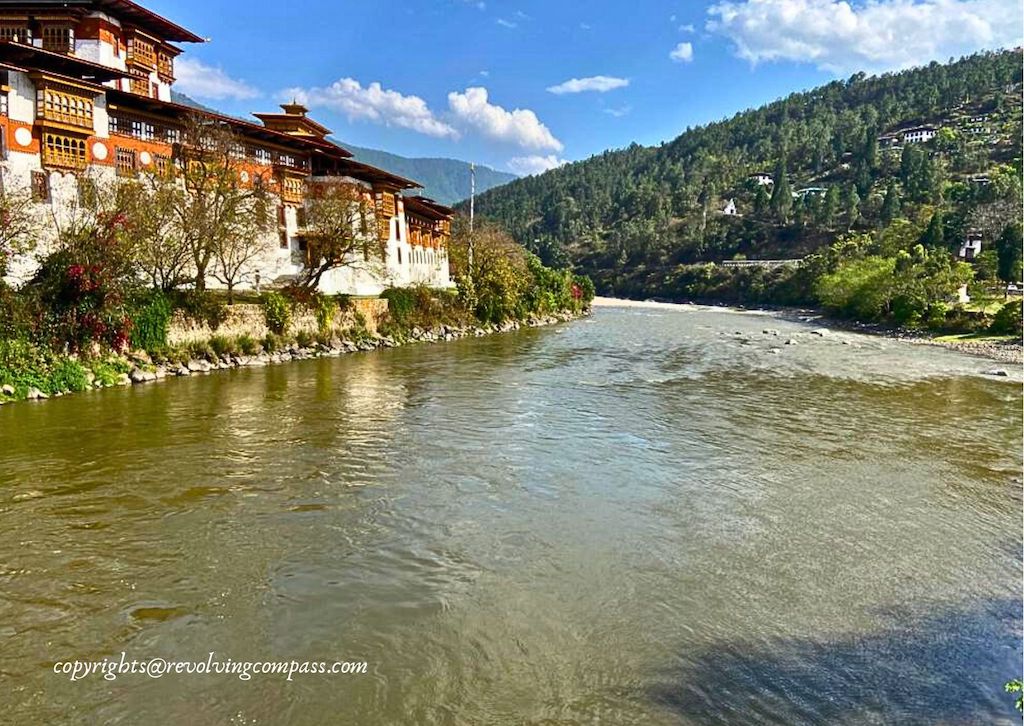
As the vehicle stopped after a few minutes, I jumped out. And the scene in front of my eyes was a completely different from what I had pictured. It was fairy tale scene – in all honestly. I was standing at the highway. Staring at one of the most beautiful scenes I had witnessed so far on my trip. As I was staring at a beautiful fortress across the river, connected from the highway by a rustic wooden bridge. With greenery all around – the whitewashed walls and carved wooden roof of the fort glowing against their backdrop !!
Entrance to the Punakha Dzong
After trying our best at capturing the beauty of the Punakha Dzong from across the highway, we were ready to start on our tour of the Punakha Dzong. We parked our vehicle in the parking lot designated for tourists visiting the fort, and proceeded to the wooden bridge . This bridge brought back memories of a similar rustic bridge we spotted while doing a walking tour in Chiang Mai on our 14 days trip to Thailand couple of years back. And also of the beautiful wooden bridge across lake Lucerne that we visited on our walking tour of Lucerne on our 4 days Switzerland Trip.
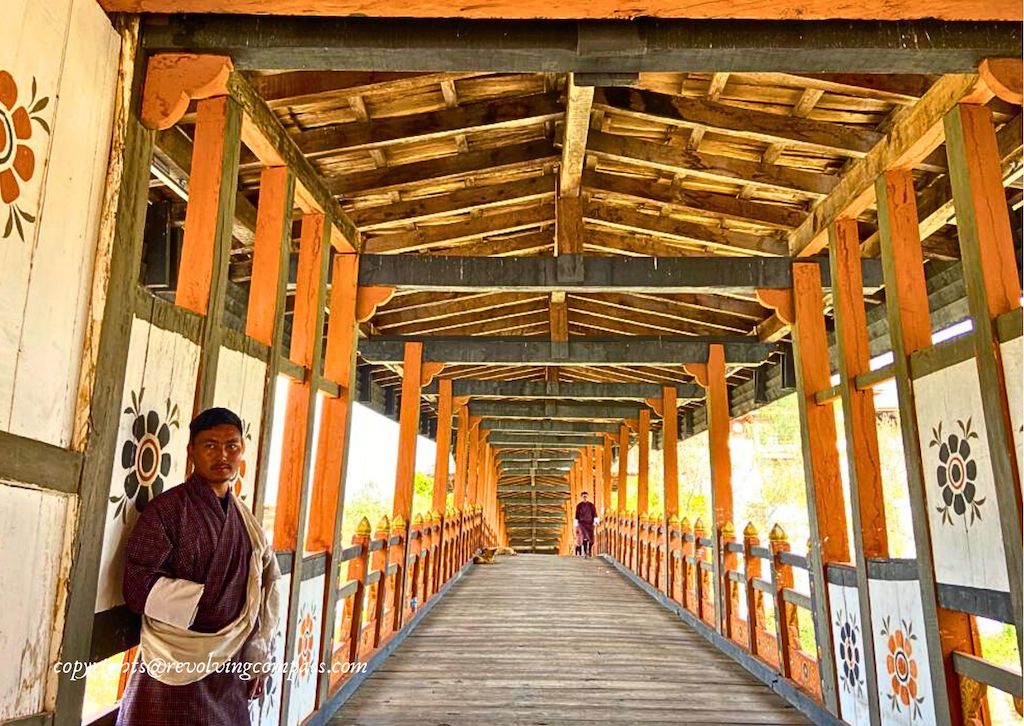
Right inside the covered bridge on the right hand side is the ticket counter. From here, we bought the entry tickets to the Punakha Dzong.
Entry ticket to Punakha Dzong is 500 Nu for adults and 250 Nu for kids. Kids under 5 years of age don’t require ticket.
Student discounts are also available at the entry ticket to Punakha Dzong. To avail the same, students need to product a valid ID card.
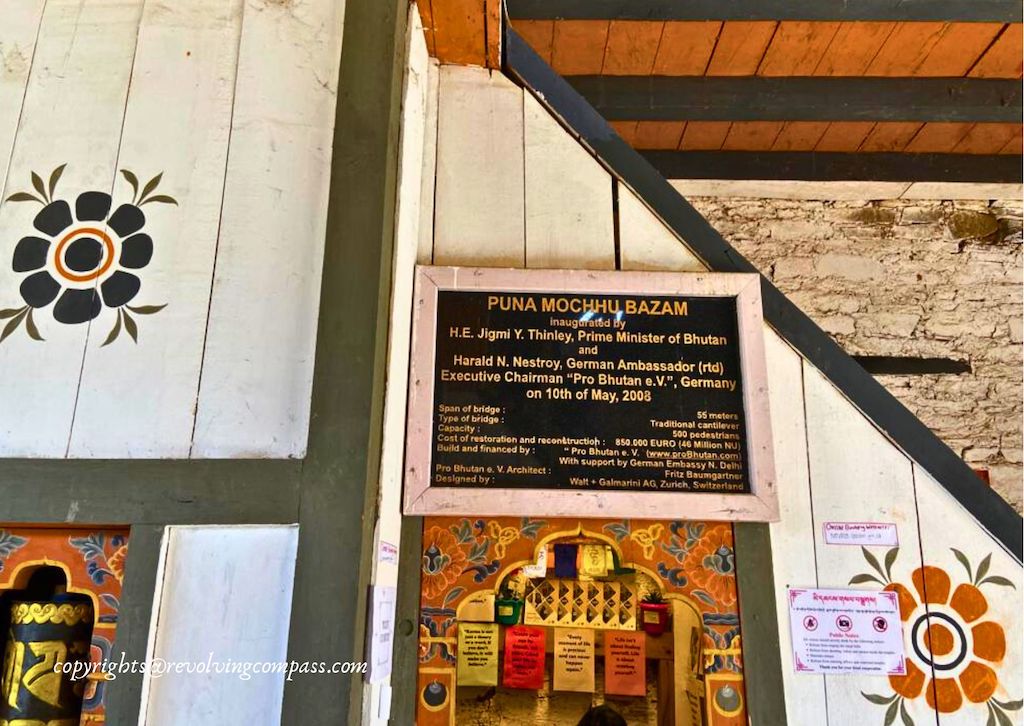
After getting the tickets, we walked across the bridge to the entry of the Punakha Dzong. But, not without stopping 10 times in between to take pictures of the scenic beauty of the river and the scene in front of us as viewed from the bridge. The way the river curves here, with pebbles on the banks and green trees high up, a few houses peeking from between then, totally reminded us of our trip to Bern in Switzerland once again. Drawing parallels, we slowly crossed the river and entered the Punakha Dzong.
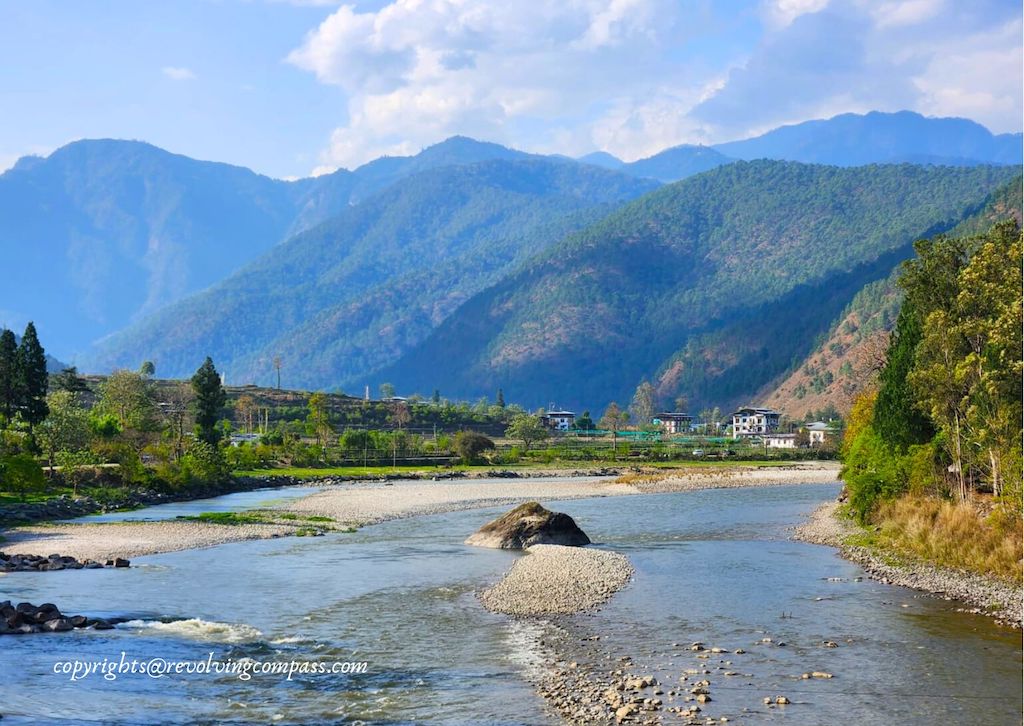
Inside the Punakha Dzong
As we stepped off the bridge and officially started our tour of the Punakha Dzong, the first thing I noticed was the “old Dzong” , a small building on the left side. It is a much smaller structure than the Punakha Dzong, with a temple inside. Which existed long before the new Dzong was constructed under Ngawang Namgyal in the 16th Century.
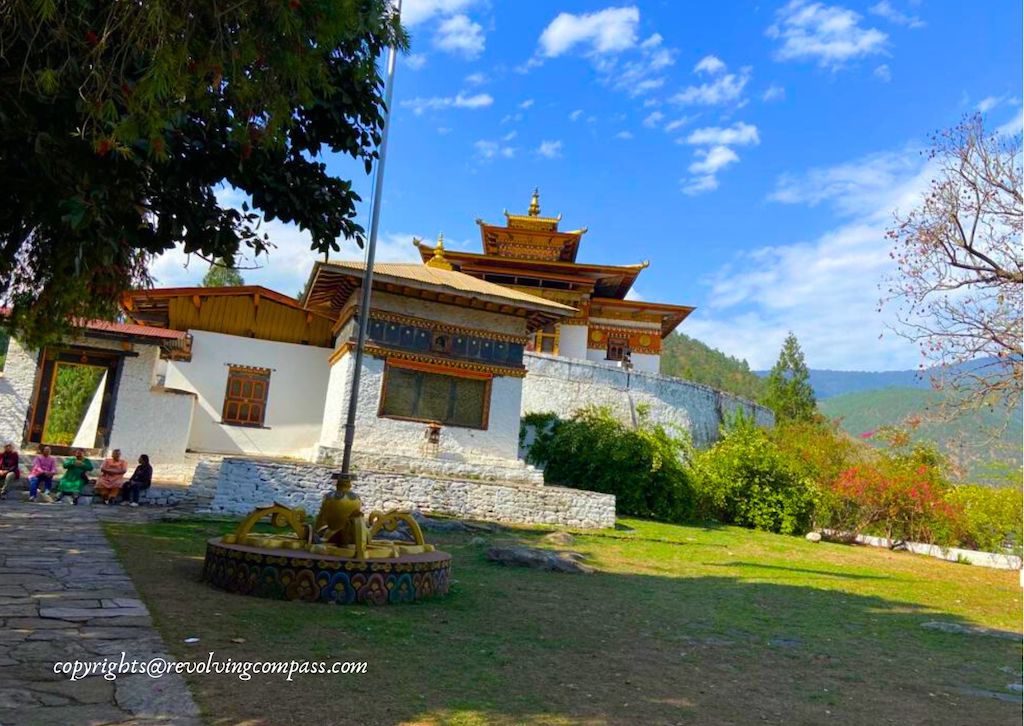
The steep stairs to the Punakha Dzong
Moving further on our tour of the Punakha Dzong, we encountered the entrance to the main building. The building is elevated and a set of really steep stairs stared at us. Challenging us to climb them. We climbed with utmost care. And while climbing, I couldn’t help but notice that the steps were divided in 3 sections. I asked Dorgie about it. And he informed that while the stairs on the two sides were used by general public for entry and exit into the fort, the ones in the middle were exclusively used only by the Royal Family when they visited here!!
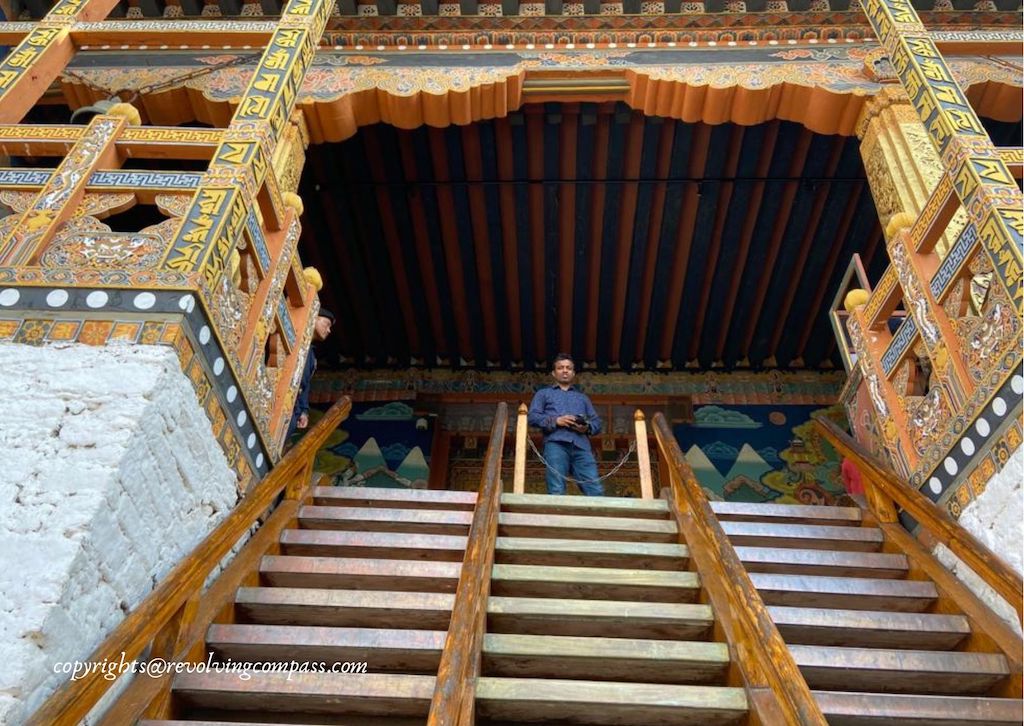
Another interesting information that he shared was that the steps were foldable. So, in case of an attack or any threat as such, they could be folded up and the entrance door to the fort closed completely! How thoughtful is that!!
As I conquered the challenge of the stairs and reached the verandah on the top, I saw beautiful paintings on the walls all over. Along side a prayer wheel on my right.
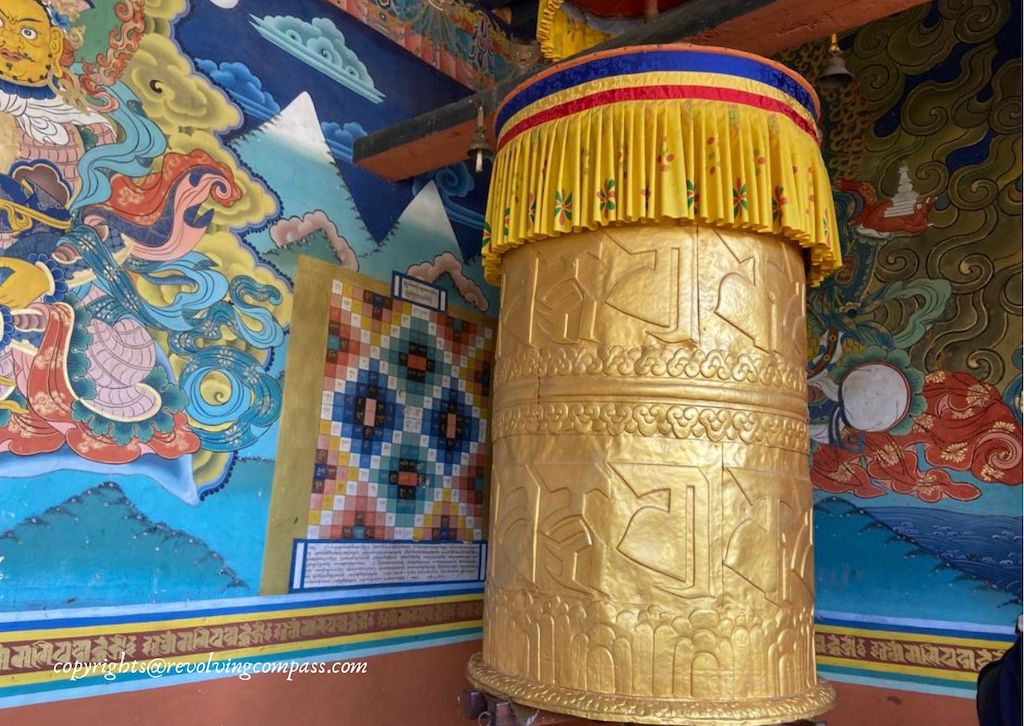
A very brief passageway connects this verandah to the first courtyard of the Punakha Dzong. This passageway is also ornately decorated with paintings depicting folk tales. Like the story of the four animals who were friends. If you have not already read about this story, read in my upcoming post on the Buddha Point.
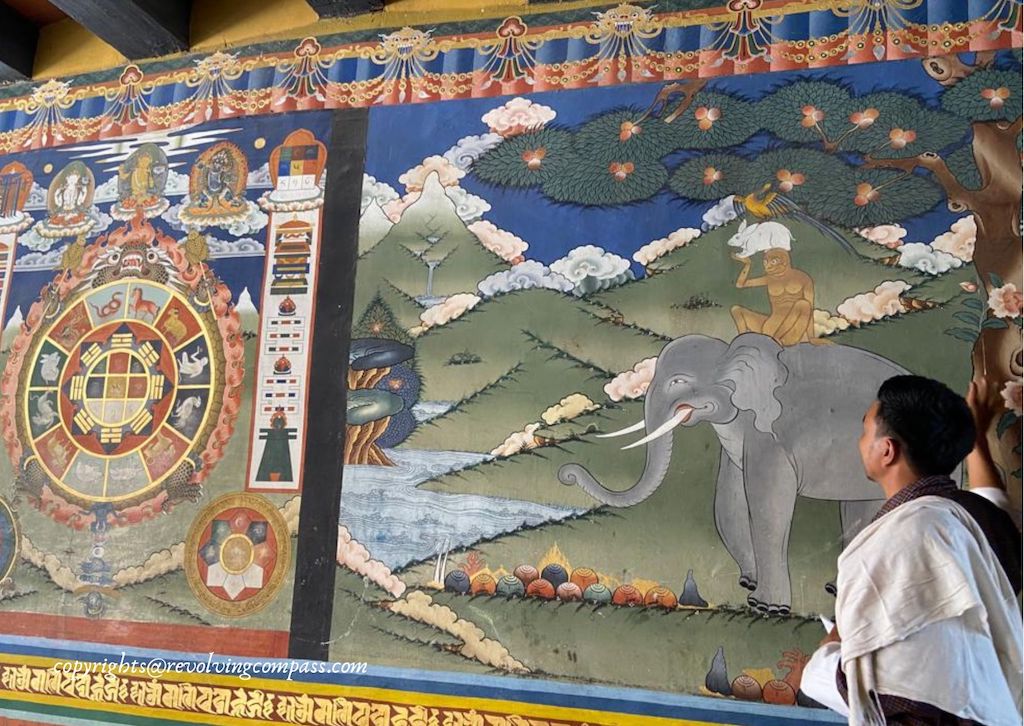
The first courtyard inside the Punakha Dzong
Continuing our tour of the Punakha Dzong, we reached the first courtyard of the Punakha Dzong. This courtyard is quiet huge. With a lush green huge peepal tree adorning the center of the courtyard. And a watch tower standing right behind it. With ornate verandah and quarters on both the sides making a multi floor building. Several beautiful windows, intricately painted pillars and carved wooden panels from doors and balconies competed for our attention. Our guide told us that this courtyard served as the administrative part of the dzong.
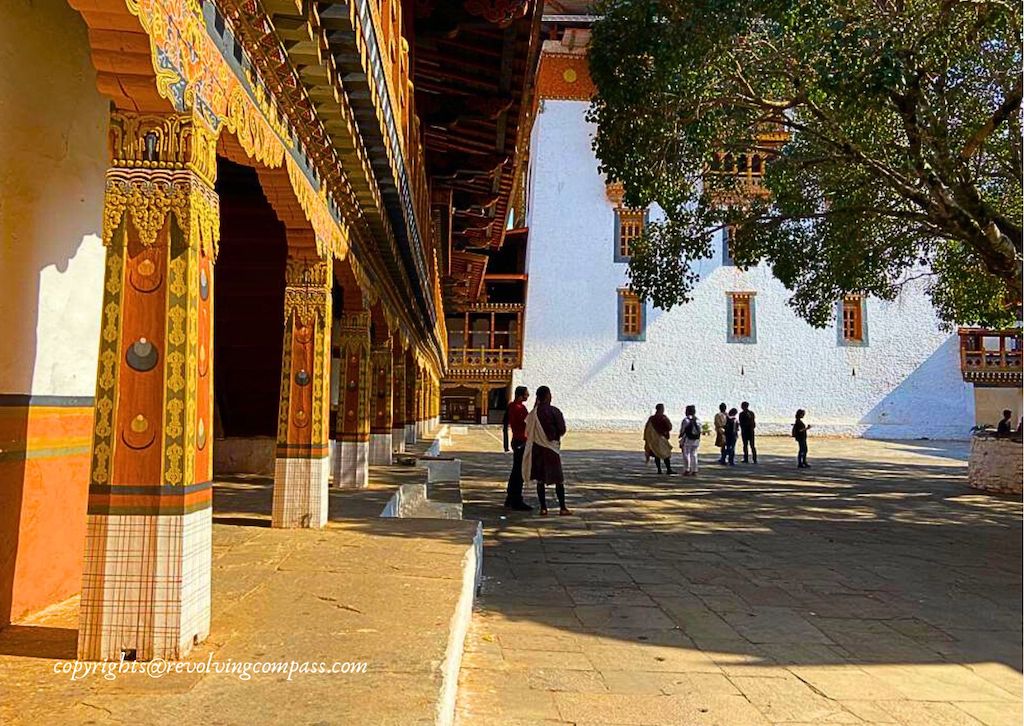
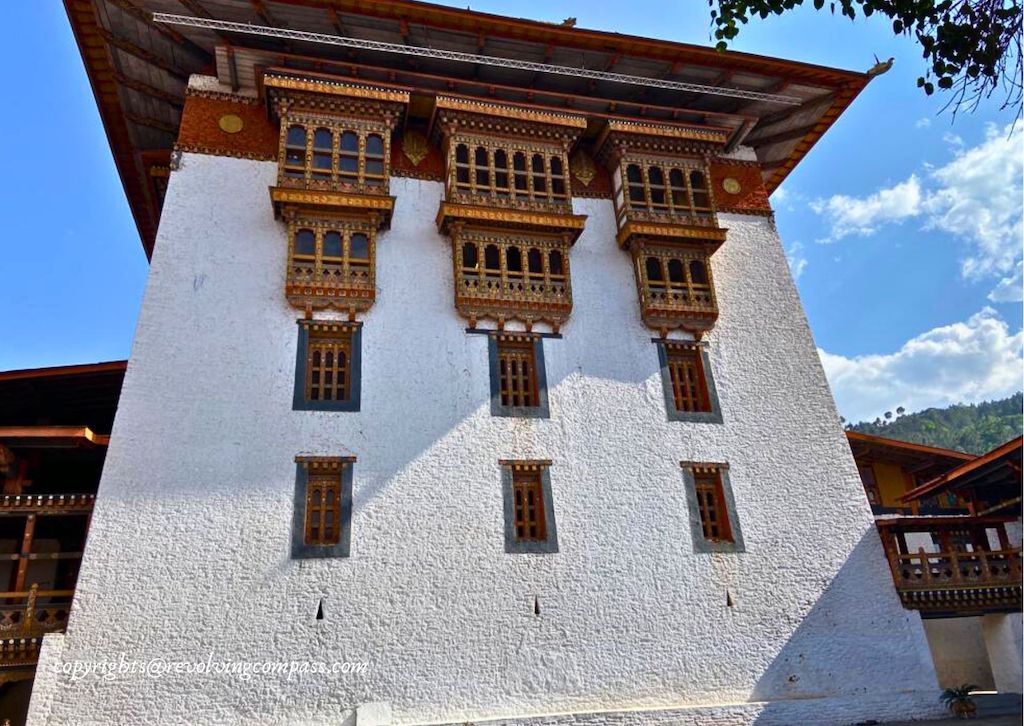
The second courtyard of the Punakha Dzong
From besides the watch tower, we entered inside a passageway to reach the second courtyard of the Punakha Dzong. The passageway was narrow with low roof. It reminded me of similar passageways we saw in the City Palace Udaipur. And our guide there had informed us they were purposefully built like that. So that enemies, even if they entered inside the Dzong, couldn’t access it’s internal quarters with speed. And that gave the people living inside the dzong time to secure themselves. Must be the same reason for the narrow , claustrophobic passageways of the Punakha Dzong as well. With all these thoughts playing in my mind, within a few moments, I was standing in the second courtyard of the Punakha Dzong.
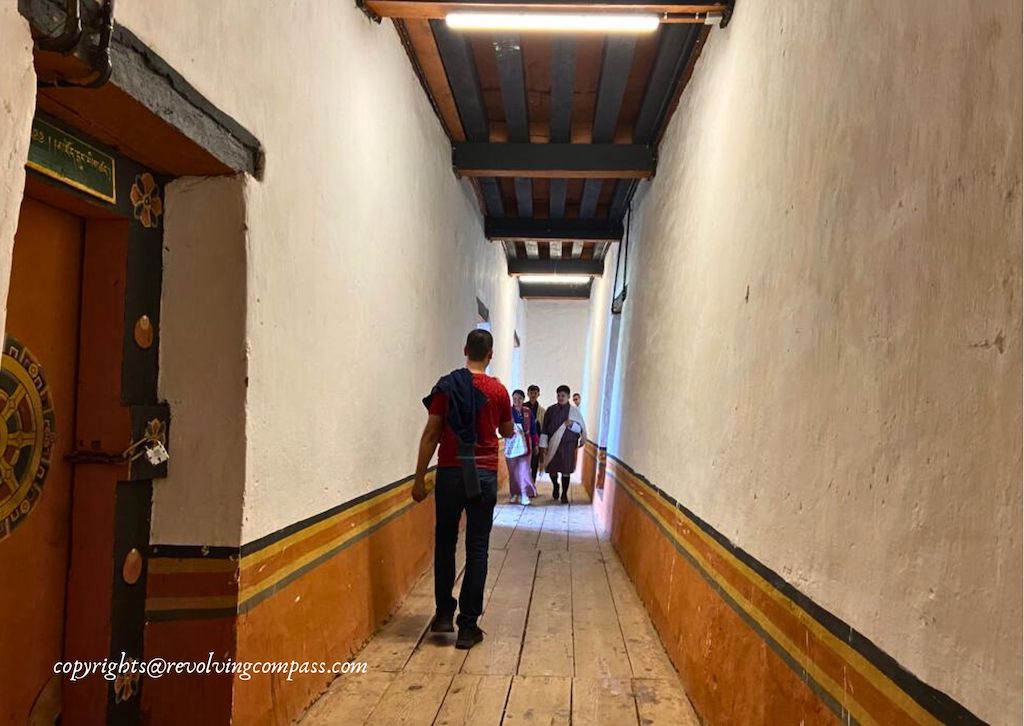
Once again, another set of beautiful windows, decorated balconies and roofs were surrounding us, the architecture identical to what we saw in the first courtyard. Along with these, I also saw a flight of stairs leading to a temple here. Our guide told us that apart from this temple, there were several other temples in this part of the Punakha Dzong. However a general public on the tour of the Punakha Dzong is not allowed to enter these temples. Only the Royal Family of Bhutan once in a while comes to offer their prayers here. And of course, the Buddhist monks living in the dzong.
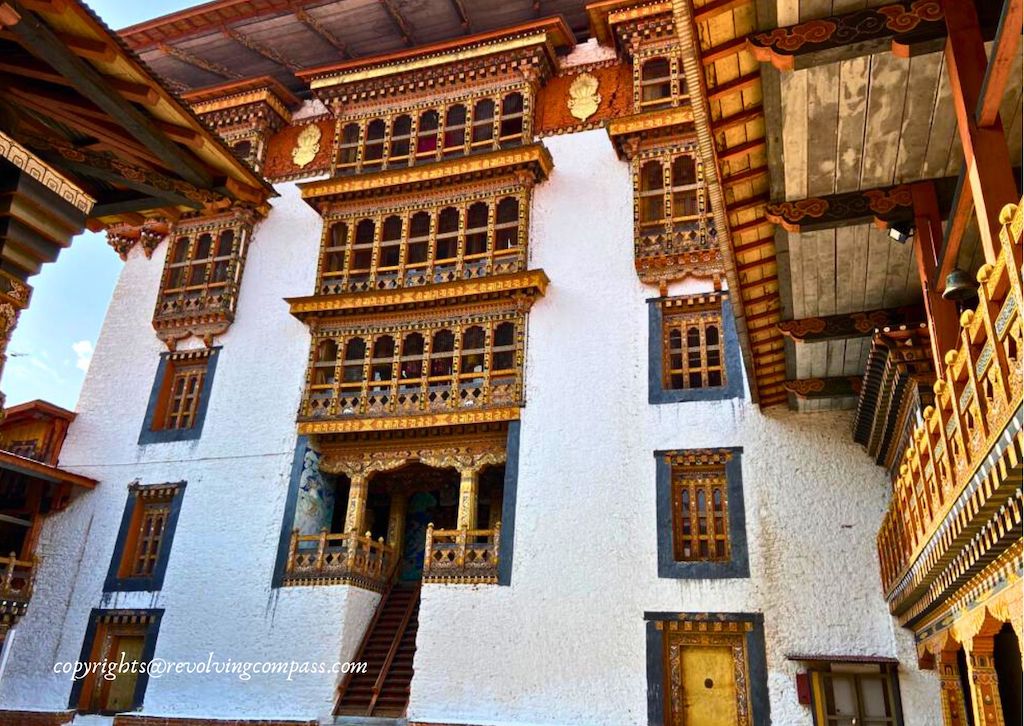
The third and final courtyard of the Punakha Dzong
Curbing my strong wish to visit one of those temples & exploring the first and higher floors of the Punakha Dzong, I continued further on my tour of the Punakha Dzong. This time, entering into the third and the final courtyard of the Punakha Dzong. This time, there was a huge monastery in front of me and a beautiful temple to my right. As per our guide, this temple on the right is visited by only the Royal Family. While some say the relics of Ngawang Namgyal are kept in this temple, some others say that there is a secret treasure in this temple. And thus the royal family visits here at least once a year to ensure the treasures are safe. Now, whether the treasure is monetary or the relics themselves might have been interpreted as the treasure remains a mystery to me!!
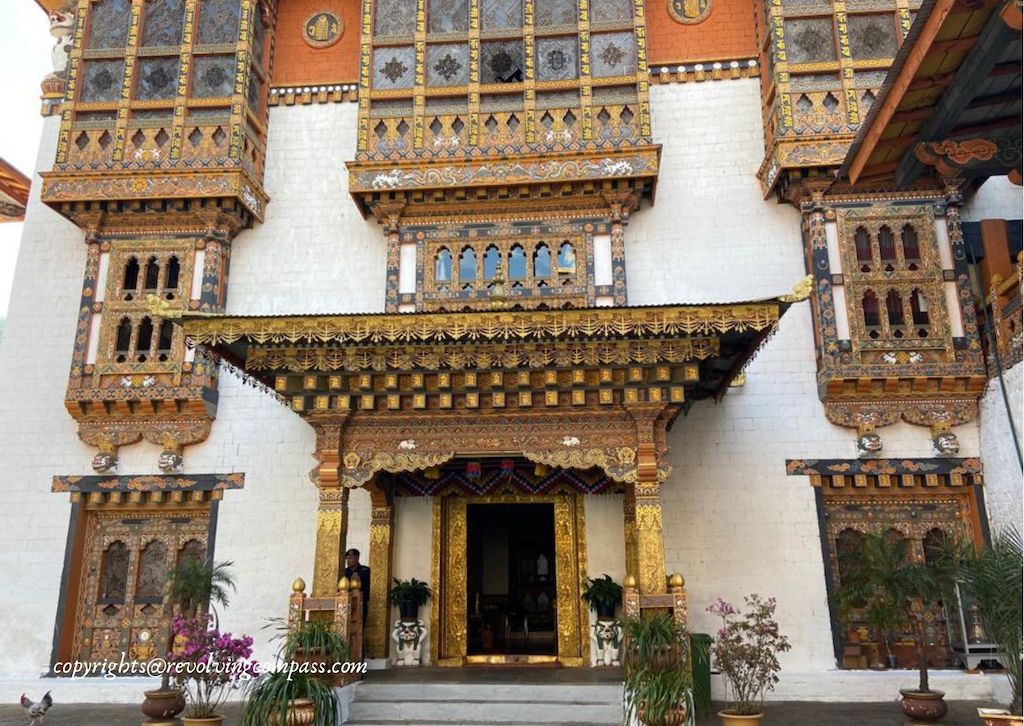
The monastery inside the third courtyard of the Punakha Dzong
To my delight, the temple in front of me was not off limit after all. We were not allowed to click pictures inside. But, we were welcome to visit inside the monastery, like most of the other monasteries of Bhutan. As I entered inside this monastery, the scene in front of me was familiar. For, it was very similar to what I have witnessed earlier in other buddhist monasteries – on my trip to Chiang Mai, or visiting the Tibatian settlement on my trip to Coorg or even the monastery we visited while exploring Palampur. Once again, drawing parallels, I stepped inside further.
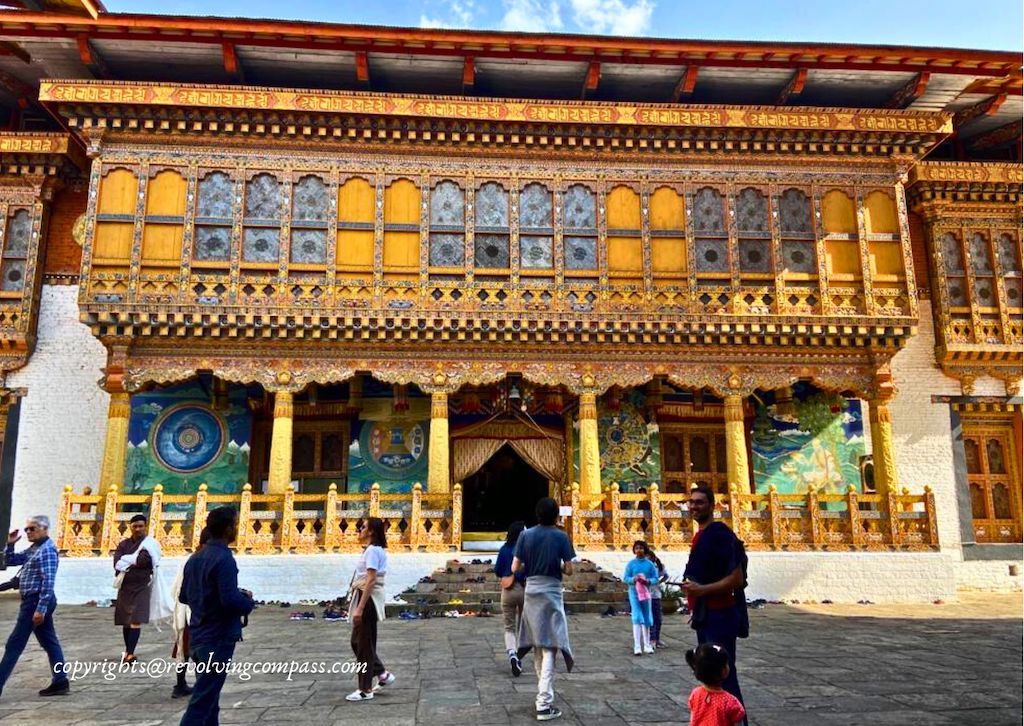
And that is when I was hit by the most unique experience of my tour of the Punakha Dzong. As hundreds of monks sat inside, chanting in unison. It was the prayer time!! The chanting of mantra in chorus by the monks was filling the whole monastery. It was loud, yet bringing utter peace to those listening to it. I was surprised how a sound so loud can have calming effect! Silently, we travellers made a round of the monastery interiors. Witnessing pictures of tales from various stages in the life of Buddha, idols of different high rank monks and tales related to how Namgyal had unified Bhutan. We crossed the big golden Buddha statue in the center of the monastery and slowly took the exit out from the other side, admiring the beauty inside.
Quarters of the monks living inside Punakha Dzong
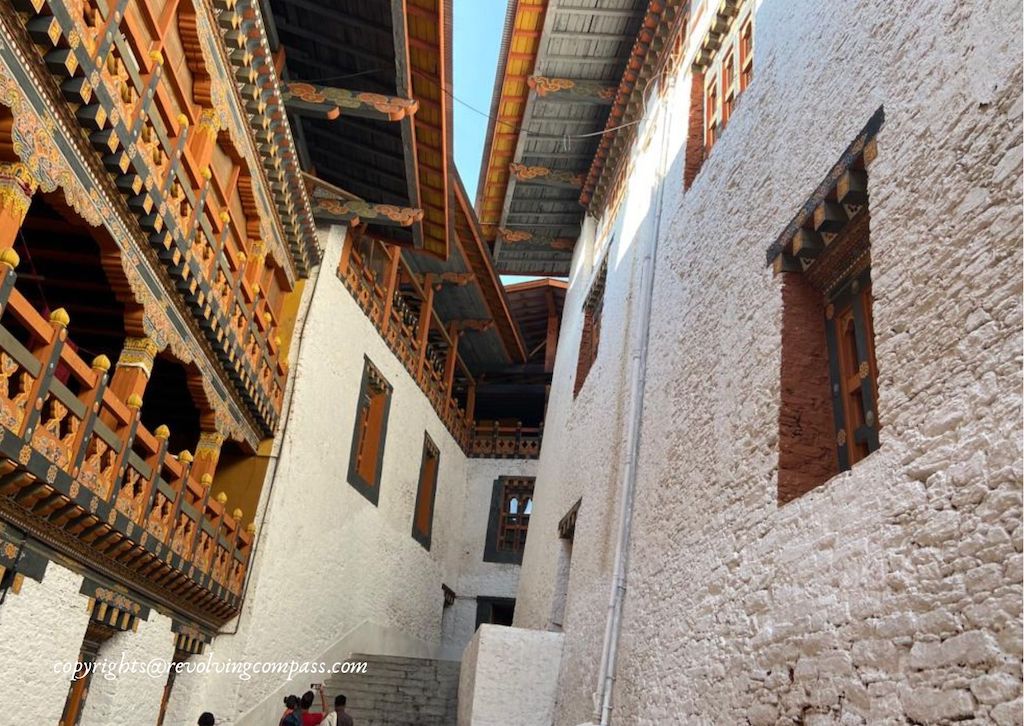
As we came out of the monastery, we moved to our left. A path leading from the courtyard to the backside of the fort. This is where the quarters of the Buddhist monks are located. They live and learn here. We crossed the quarters and started towards the direction we had come from. Eventually finding ourselves standing in the first courtyard once again. We rested here on the stairs for a while. And also clicked some forever memorable pictures. Before exiting out of the Punakha Dzong. Thus, officially ending our tour of the Punakha Dzong.
A brief history of Punakha Dzong
The history of Punakha Dzong is as interesting as the dzong itself. It is said that in the 8th century there was a prophecy that a new dzong will be built at Punakha by a person who will visit from far. Centuries after, in the 1600s an architect, Zowe Palep, had a vision while sleeping under a small statue of Buddha. The vision or the dream as it was, instructed him to travel to Punakha valley and build this dzong as a palace for Guru Rinpoche. The vision was so clear, that he didn’t even need to put the plans of the fortress on paper. And within one year, the Punakha Dzong was ready. While this was happening, in parallel, Ngawang Namgyal was unifying the kingdom of Bhutan as we know it. Eventually, the Punakha Dzong came to hold his relics.
Some more interesting facts about the Punakha Dzong
- The wooden bridge that connects the Punakha fort to the main land was actually destroyed in a flood. But the new bridge was then constructed so skillfully that it looks as rustic and old. If your guide will not point it to you, you will never actually know!
- Only the courtyards and the monastery in the third courtyard of the Punakha Dzong are actually accessible to the public. Rest everything is off limit. You can however glimpse them from outside.
- Some say that one of the temples in the third courtyard contains treasure. But no one is able to confirm this theory for sure.
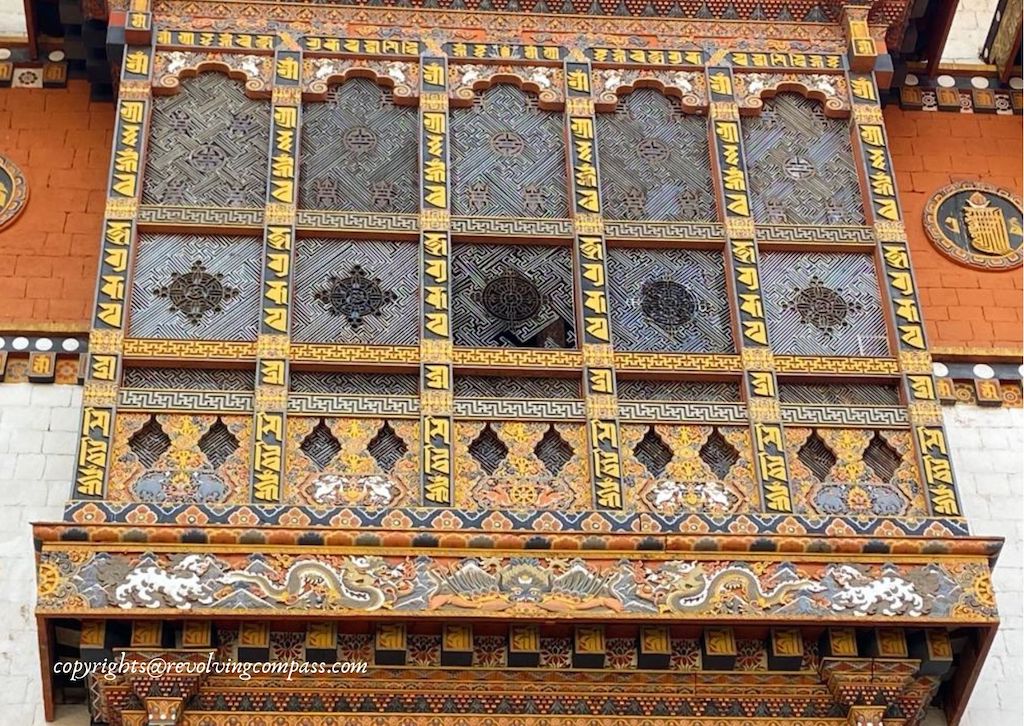
General tips on doing a tour of the Punakha Dzong
- One must be accompanied by a guide while visiting the Punakha Fort.
- The timings of the Punakha Dzong are from 9:00am to 1:00pm and then from 2:00pm to 4:30pm.
- There is a suspension bridge near the Punakha Dzong that connects the Dzong to the main town of Punakha. I will soon elaborate on our experience visiting this bridge. If you have ample time after visiting the Punakha Dzong, then do visit here.
- You must have your legs and arms covered while visiting the Punakha Dzong. As there are temples and monasteries inside.
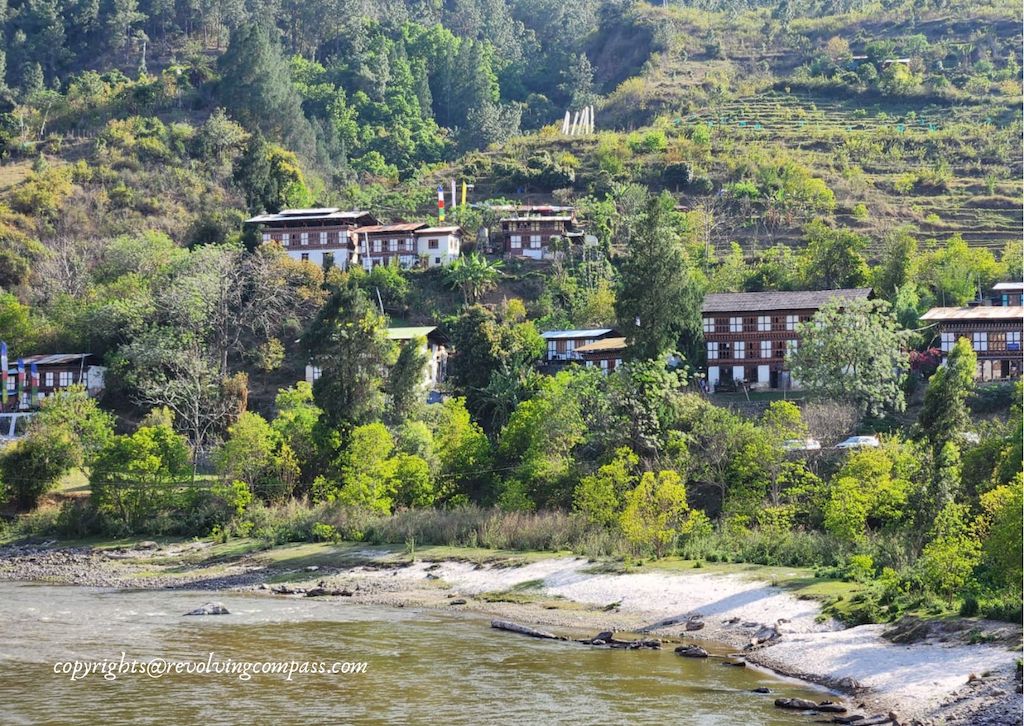
Tips on doing a tour of Punakha
- Punakha is a small valley-town in Bhutan, which is located at almost 70km (~2.5-3 hrs) distance from Thimphu.
- There are several things to do in Punakha that I have covered in this post here.
- You should plan for minimum 2 nights stay in Punakha to do justice to all the places to see and things to do in Punakha
- Punakha is usually warmer than Thimphu and Paro, still gets considerably cold in the winters
- The only way to reach Punakha is through roadways, there is no rail network in Bhutan.
- Punakha is also famous for it’s substantial production of rice.
- You can browser the list of hotels to stay in Punakha here.
Other useful resources from our Bhutan trip
Our 7 days Bhutan trip itinerary
A complete guide to visit Bhutan that contains all the information you need to know before visiting Bhutan
How to obtain a Bhutan Permit for Indian Tourists visiting Bhutan
Places to see in Thimphu in one day
An adventure on Punakha Suspension Bridge
Hiking the Tiger’s Nest Monastery
PS: Some of our links are affiliated, this means we will earn a commission when you buy a service or product by clicking those links. However, this will have no extra cost for you.